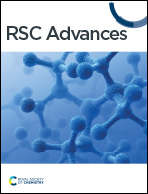Synthesis and electrochemical evaluation of nickel hydroxide nanosheets with phase transition to nickel oxide†
Abstract
Transition metal hydroxides are commonly used to develop nanostructures with desired functionalities by controlling their size, morphology, and structure. In this study, nickel hydroxide nanosheets with a hexagonal island shape are synthesized via a surfactant-assisted method. Using this method, nickel hydroxide nanosheets can be easily achieved in a quick manner. The synthesized nanosheets are 3–6 nm thick and exhibit a curly and wrinkled morphology with increasing surfactant concentration. These nanosheets demonstrate superior catalytic properties for the oxygen evolution reaction activity compared to nickel oxide sheets obtained via a simple heat treatment. Furthermore, we conduct surface enhanced Raman scattering analysis to confirm that the nickel hydroxide nanosheets serve as active species for NiOOH during the oxygen evolution reaction, and we propose an electrochemical mechanism for this system. This study not only presents the detailed synthesis process but also proposes a straightforward approach, offering valuable insights into the structural and electrochemical properties of the resulting nanosheets.



 Please wait while we load your content...
Please wait while we load your content...